Article category
- Page Path
-
- HOME
- ARTICLE CATEGORY
- Article category
- Review Article
- Neonatology (Perinatology)
- Recent advances in understanding pathophysiology of non-nutritional stunting in very preterm infants
- Eduardo Cuestas, Alina Rizzotti
- Clin Exp Pediatr. 2025;68(4):287-297. Published online December 23, 2024
-

· Previous reviews of extrauterine growth restriction focused mainly on weight growth restriction caused by nutritional factors or pathological conditions.
· This review summarizes recent developments in the pathophysiology of nonnutritional length growth restriction in very preterm infants with focus on the impact of sustained neonatal inflammation on their short- and long-term outcomes.
· Further research is needed to investigate optimal strategies to improve length growth restriction in very preterm infants.
- Cardiology
- Lifelong impact of elevated blood pressure from childhood to adulthood
- Junhyun Kwon, Eunji Kim
- Clin Exp Pediatr. 2025;68(4):278-286. Published online November 28, 2024
-

· Childhood blood pressure (BP) is significantly associated with adult hypertension and cardiovascular disease.
· Despite ongoing debate regarding the need for regular BP screening and early pharmacotherapy in children, the benefits of optimizing BP throughout childhood are clear.
· Childhood presents a critical window for normalizing BP through lifestyle modifications such as reducing sodium intake and increasing physical activity to promote lifelong cardiovascular health and prevent longterm complications.
- Neurology
- Cerebral organoid research for pediatric patients with neurological disorders
- Jin Eun, Jung Eun Lee, Seung Ho Yang
- Clin Exp Pediatr. 2025;68(4):269-277. Published online November 28, 2024
-

Cerebral organoids obtained from human induced pluripotent stem cells are transforming the study of pediatric neurological diseases by providing more accurate models of human brain development and pathology. These advancements have improved pathology modeling and the potential for novel therapeutic approaches despite existing challenges such as reproducibility and vascularization.
- Clinical Note
- Gastroenterology
- Congenital antral web: rare cause of gastric outlet obstruction successfully managed with endoscopic balloon dilatation
- Upasana Ghosh, Ujjal Poddar, Srinivas Srinidhi Vadlapudi, Moinak Sen Sarma, Anshu Srivastava
- Clin Exp Pediatr. 2025;68(3):266-268. Published online January 13, 2025
-
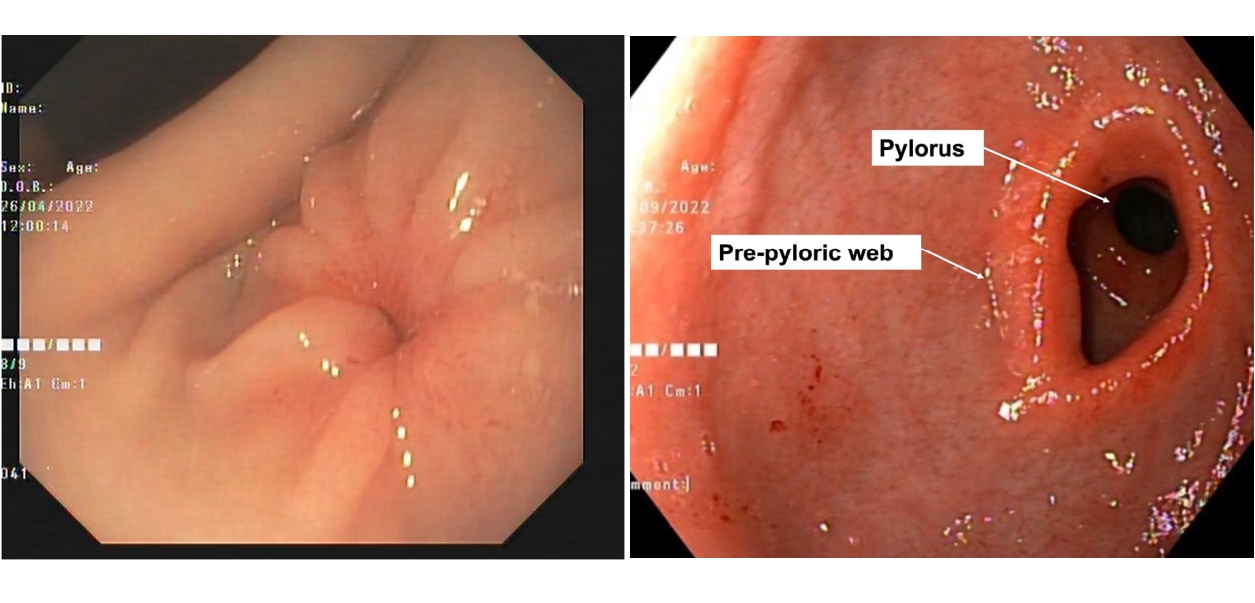
- Original Article
- Genetics and Metabolism
- Long-term follow-up of neurocognitive function in patients with citrin deficiency and cholestasis
- Meng-Ju Melody Tsai, Jung-Chi Chang, Heng-Yu Lu, Susan Shur-Fen Gau, Yin-Hsiu Chien, Wuh-Liang Hwu, Yen-Hsuan Ni, Huey-Ling Chen, Ni-Chung Lee
- Clin Exp Pediatr. 2025;68(3):257-265. Published online November 28, 2024
-
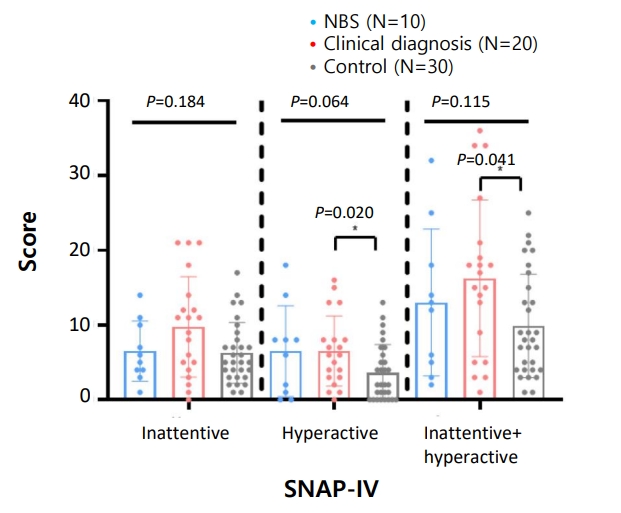
Question: Do transient metabolic disturbances in early childhood due to citrin deficiency have lasting effects on neurocognitive function?
Finding: Children with citrin deficiency have a higher prevalence of ADHD compared to the general population, with elevated ammonia levels in infancy associated with increased hyperactivity-impulsivity risk.
Meaning: Metabolic disturbances in early childhood due to citrin deficiency may contribute to long-term neurocognitive impacts, particularly ADHD, while IQ and life outcomes generally remain normal.
- Gastroenterology
- Outcome of pediatric inflammatory bowel disease in Asian children: a multinational 1-year follow-up study
- Pornthep Tanpowpong, Suporn Treepongkaruna, James Guoxian Huang, Kee Seang Chew, Karen Sophia Calixto Mercado, Almida Reodica, Shaman Rajindrajith, Wathsala Hathagoda, Yoko Kin Yoke Wong, Way Seah Lee, Marion Margaret Aw
- Clin Exp Pediatr. 2025;68(3):247-256. Published online November 13, 2024
-

Question: Short-term (1-year) follow-up data in pediatric patients with inflammatory bowel disease (IBD), especially in Southeast Asian countries, are limited.
Finding/Meaning: Abdominal pain and pallor rates remained high at 1 year after IBD diagnosis. Three independent factors of 1-year clinical remission for Crohn disease were oral prednisolone, antibiotic, and immunomodulator use at 1-year follow-up. A history of weight loss at diagnosis was the only independent risk factor of IBD flare.
- Endocrinology
- Prednisolone impairs trabecular bone score changes in adolescents with 21-hydroxylase deficiency
- Pattara Wiromrat, Yutapong Raruenrom, Phanpaphorn Namphaisan, Nantaporn Wongsurawat, Ouyporn Panamonta, Chatlert Pongchaiyakul
- Clin Exp Pediatr. 2025;68(3):238-246. Published online November 13, 2024
-
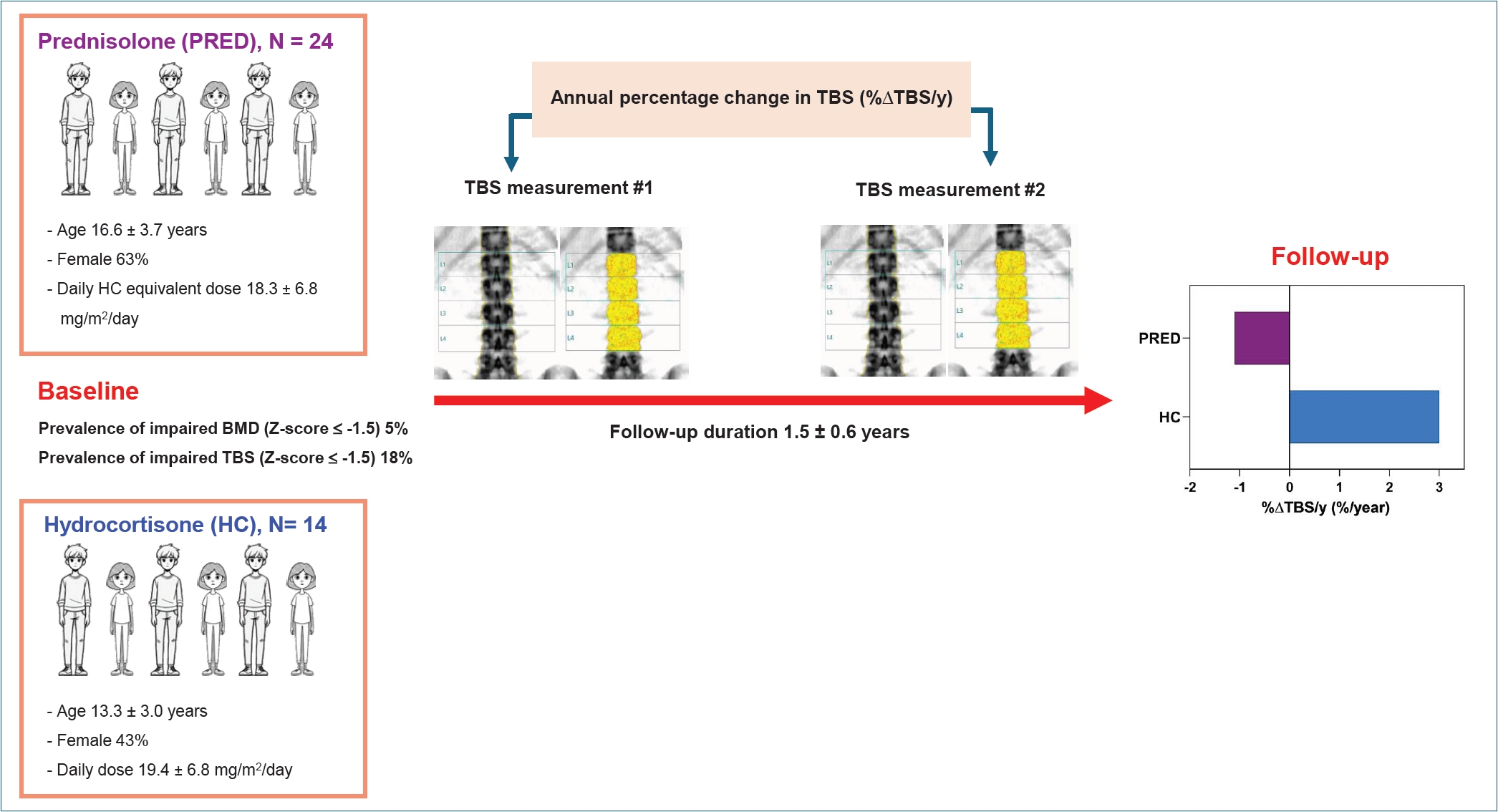
Question: What is the prevalence of an impaired trabecular bone score (TBS), a measure of bone microarchitecture, in adolescents with 21-hydroxylase deficiency (21OHD)? Do prednisolone and hydrocortisone affect TBS differently in this patient population?
Finding: Impaired TBS was observed in 18% of participants. Prednisolone use negatively impacted TBS change.
Meaning: Impaired TBS is prevalent among adolescents with 21OHD. Prednisolone impairs trabecular bone microarchitecture development.
- General Pediatrics
- Knowledge, attitude, and practice regarding dengue vaccine: a baseline study of community members and health providers in Indonesia
- Abdul Wahab, Ida Safitri Laksanawati, Retna Siwi Padmawati, Asal Wahyuni Erlin Mulyadi, Wahyu Triadmajani, Jarir At Thobari
- Clin Exp Pediatr. 2025;68(3):228-237. Published online November 13, 2024
-
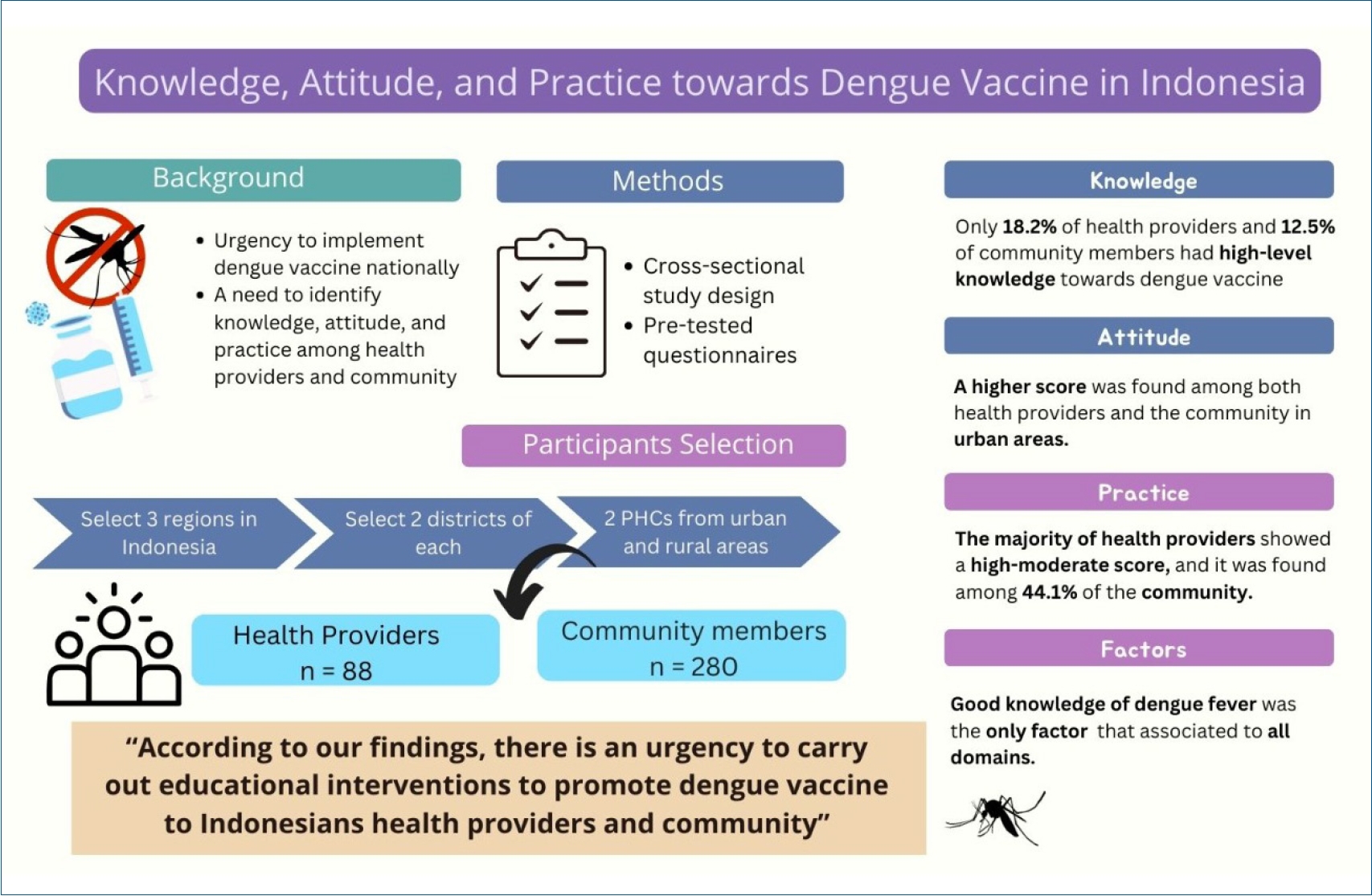
Question: Do community members and health providers show different level of knowledge, attitude, and practice towards dengue vaccine?
Finding: These 2 groups only differed in practice component, while the knowledge and attitude constituents were relatively low for both.
Meaning: There is an urgent need to deliver educational interventions to raise awareness of community members and health providers regarding dengue vaccination.
- Editorial
- Neonatology (Perinatology)
- The predetermined future: tackling South Korea’s total fertility rate crisis
- Jin Kyu Kim
- Clin Exp Pediatr. 2025;68(3):225-227. Published online November 6, 2024
-
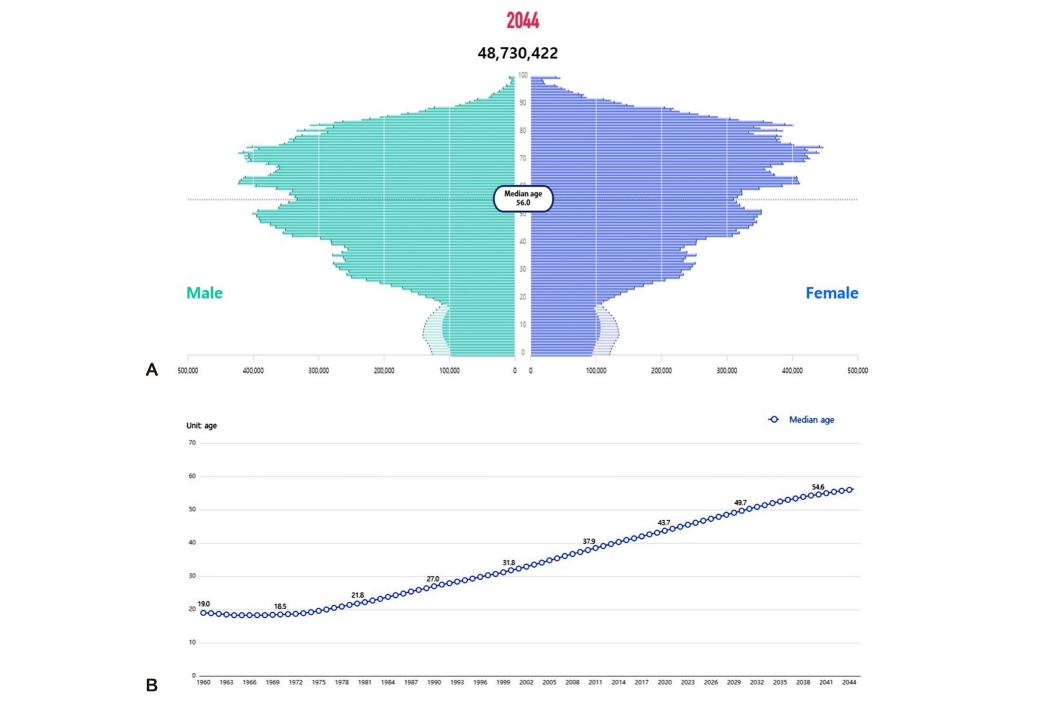
· South Korea faces a severe demographic crisis with the lowest global fertility rate. Despite significant investments, the total fertility rate continues to decline.
· It is necessary to fully mobilize national capabilities and execute comprehensive strategies that focus on both intangible and tangible values.
· Immediate and decisive action is essential to addressing these challenges effectively.
- Nutrition
- Zinc as a treatment modality for acute infectious diarrhea in children
- Ji Sook Park
- Clin Exp Pediatr. 2025;68(3):223-224. Published online October 31, 2024
-
· Prevention and management of dehydration is the major goal of treatment in acute infectious diarrhea in children.
· Zinc could be effective as an adjuvant therapy in reducing the duration of acute infectious diarrhea in malnourished children.
- Review Article
- Endocrinology
- Hidden link between endocrine-disrupting chemicals and pediatric obesity
- Min Won Shin, Shin-Hye Kim
- Clin Exp Pediatr. 2025;68(3):199-222. Published online November 28, 2024
-
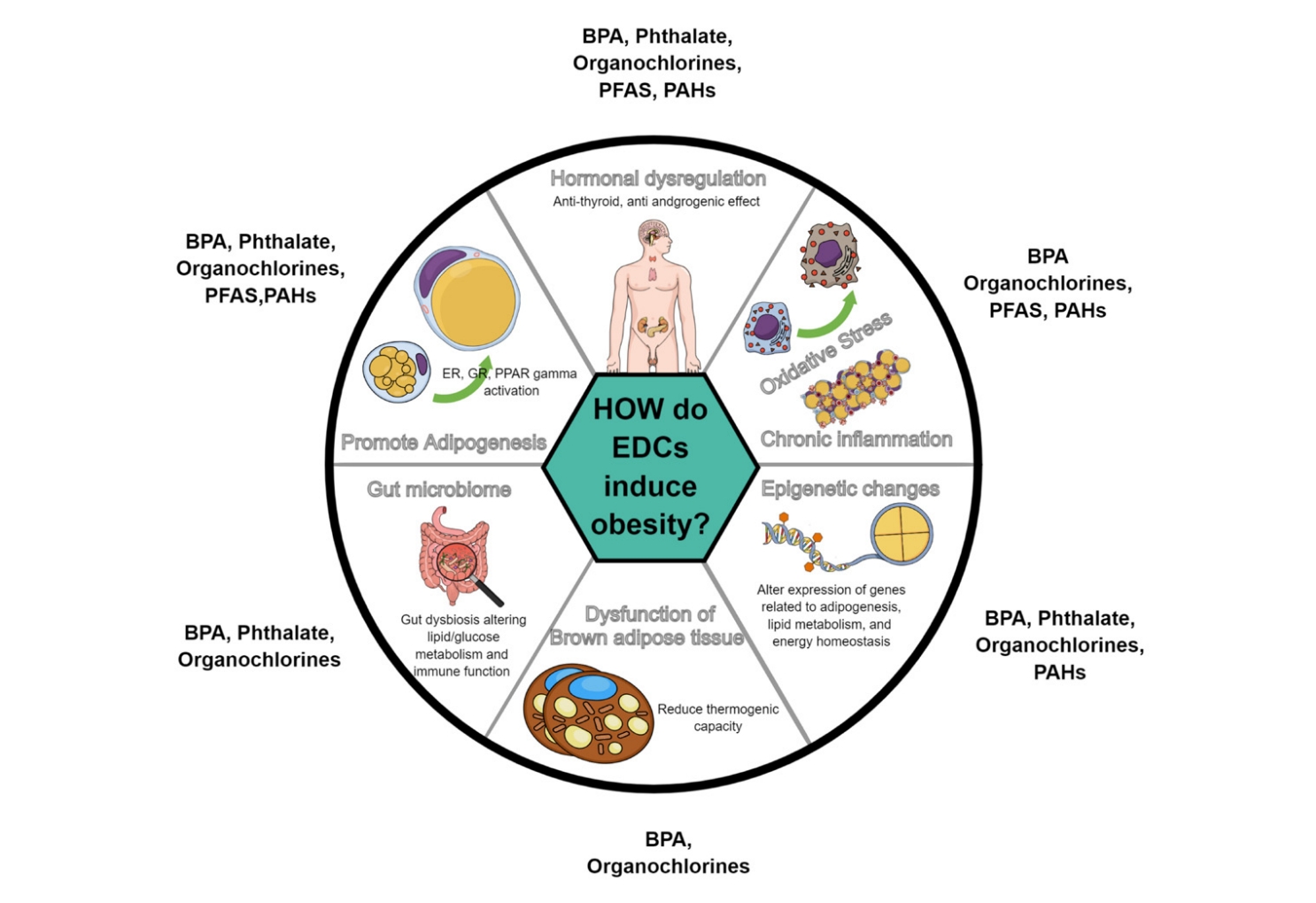
Studies indicate potential connections between exposure to endocrine-disrupting chemicals (EDCs) and childhood obesity. Variations in the impact of EDCs in epidemiological studies may result from differences in exposure concentrations and timing, measurement methods, and interactive effects of multiple EDCs. Longitudinal studies on exposure to multiple EDCs are crucial to elucidating their contribution to pediatric obesity and minimize the adverse health consequences of EDC exposure.
- Gastroenterology
- Practical concepts and strategies for early diagnosis and management of eosinophilic gastrointestinal disorders in East-Asian children
- Byung-Ho Choe
- Clin Exp Pediatr. 2025;68(3):185-198. Published online November 13, 2024
-
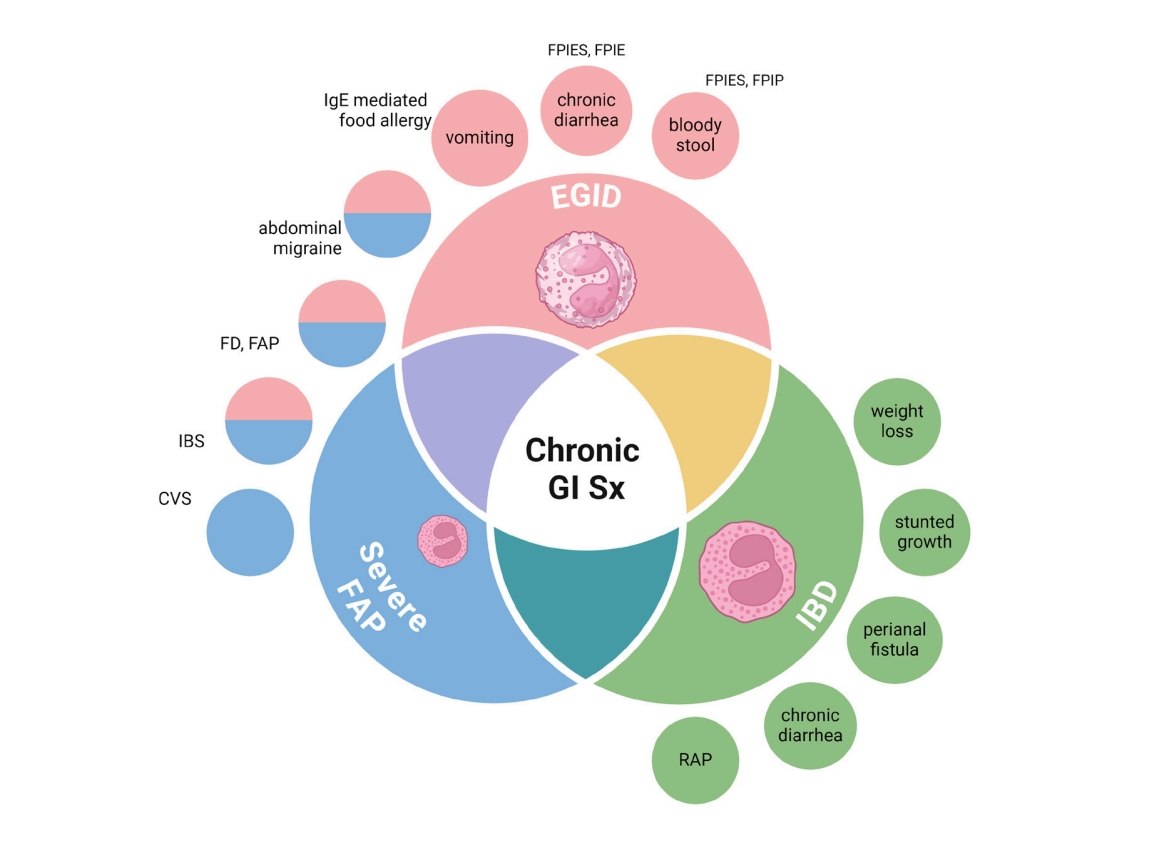
Eosinophilic gastrointestinal disorders (EGIDs) often coexist with functional gastrointestinal disorders (FGIDs) and other IgE or non-IgE mediated GI diseases. Diagnosing EGIDs requires a high index of suspicion and a comprehensive approach to differentiate them from conditions like inflammatory bowel disease. Tests such as fecal calprotectin and biopsies aid in severe cases. Maintaining a food diary helps identify triggers for long-term elimination. Awareness and education are key to effective management.
- Original Article
- Neonatology (Perinatology)
- Effect of high-frequency oscillatory ventilation with intermittent sigh breaths on carbon dioxide levels in neonates
- Kulthida Baingam, Anucha Thatrimontrichai, Manapat Praditaukrit, Gunlawadee Maneenil, Supaporn Dissaneevate
- Clin Exp Pediatr. 2025;68(2):178-184. Published online November 13, 2024
-
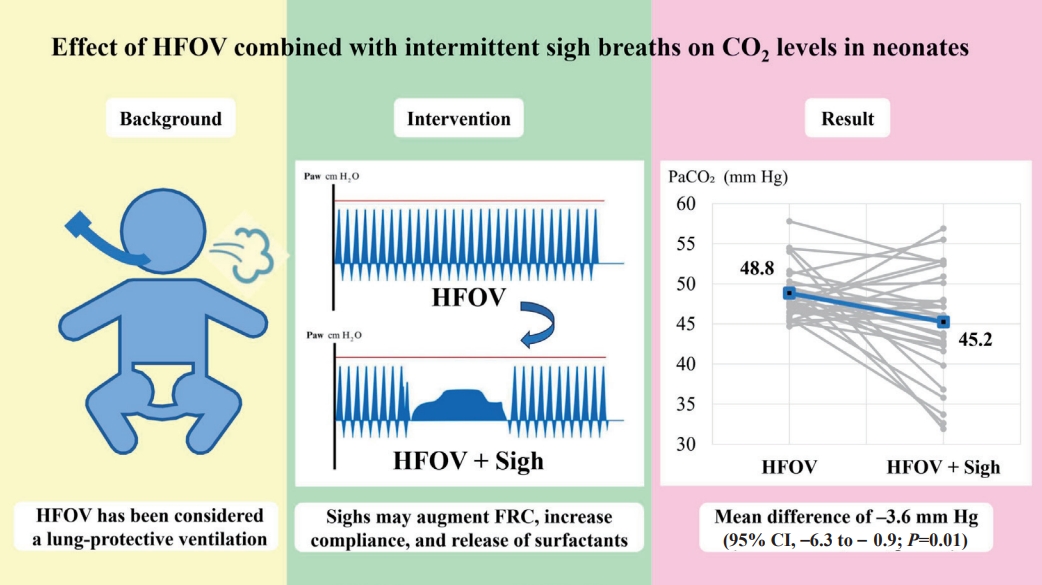
Question: Can sigh breaths (Sighs) application during high-frequency oscillatory ventilation (HFOV) decrease partial pressure of carbon dioxide (PaCO2) levels?
Finding: The mean PaCO2 level after Sighs during HFOV was significantly decreased compared to that after HFOV alone (mean difference, -3.6 mmHg).
Meaning: HFOV plus Sighs functionality can reduce PaCO2 levels. However, further studies are required to conclusively determine the effects of Sighs.
- Developmental and Behavioral Medicine
- Characteristics of temper tantrums in 1–6-year-old children and impact on caregivers
- Warangkana Prutipaisan, Issarapa Chunsuwan, Tippawan Hansakunachai, Paskorn Sritipsukho
- Clin Exp Pediatr. 2025;68(2):170-177. Published online November 13, 2024
-
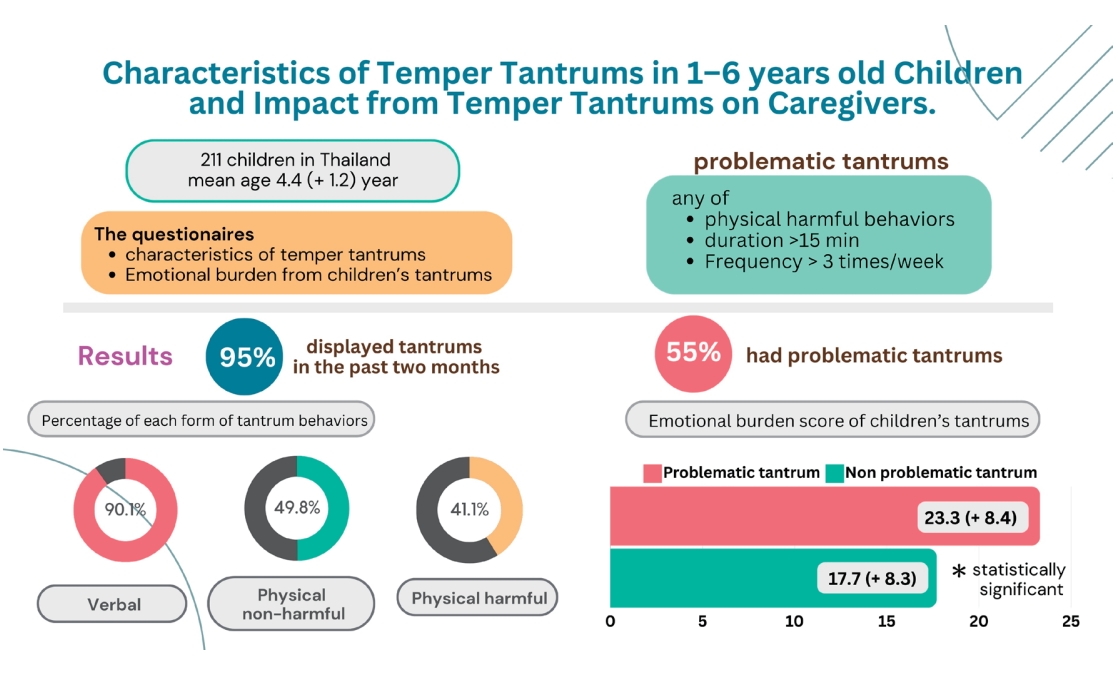
Question: What are common tantrum behaviors in preschool children, and how frequently are problematic behaviors observed? Do problematic tantrums have a different emotional impact on caregivers compared to typical tantrums?
Finding: Temper tantrums are common in preschool children, and verbal tantrums are the most common type.
Meaning: Problematic tantrums, defined as tantrums exhibiting aggressive physical behavior, long duration (>15 minutes), or frequent occurrence (>3 days/wk), significantly affected caregivers’ emotions.
- Neurology
- Evaluation of pediatric migraine triggers: a single-center study
- Hey-Joon Son, Joo-Ok Jin, Kon-Hee Lee
- Clin Exp Pediatr. 2025;68(2):163-169. Published online November 11, 2024
-

Question: What are the primary triggers for pediatric migraines, and how do they impact clinical management?
Finding: Common triggers for pediatric migraines include sleep disturbances, academic stress, and motion sickness, with academic stress identified as the most intense.
Meaning: Recognizing and addressing specific triggers like sleep disturbance and academic stress is crucial to effectively managing pediatric migraines with emphasis on personalized care to improve outcomes.
- Infection
- Clinical characteristics and associated factors of pediatric acute necrotizing encephalopathy: a retrospective study
- Huiling Zhang, Yilong Wang, Qianyun Ding, Xuekun Li, Sheng Ye
- Clin Exp Pediatr. 2025;68(2):153-162. Published online November 11, 2024
-

· The mortality rate of acute necrotizing encephalopathy was high.
· Laboratory tests revealed that the fatal group had higher creatinine, lactate, activated partial thromboplastin time, thrombin time, interleukin (IL)-6, IL-10, creatine kinase, and D-dimer than survivors.
· The fatal group displayed lower Glasgow Coma Scale scores and arterial pH.
- Gastroenterology
- Differences in immune cells and gene expression in human milk by parity on integrated scRNA sequencing
- Dae Yong Yi, Hong-Jai Park, Min Sun Shin, Hyoungsu Kim, Sang Jin Lee, Insoo Kang
- Clin Exp Pediatr. 2025;68(2):141-152. Published online January 10, 2025
-
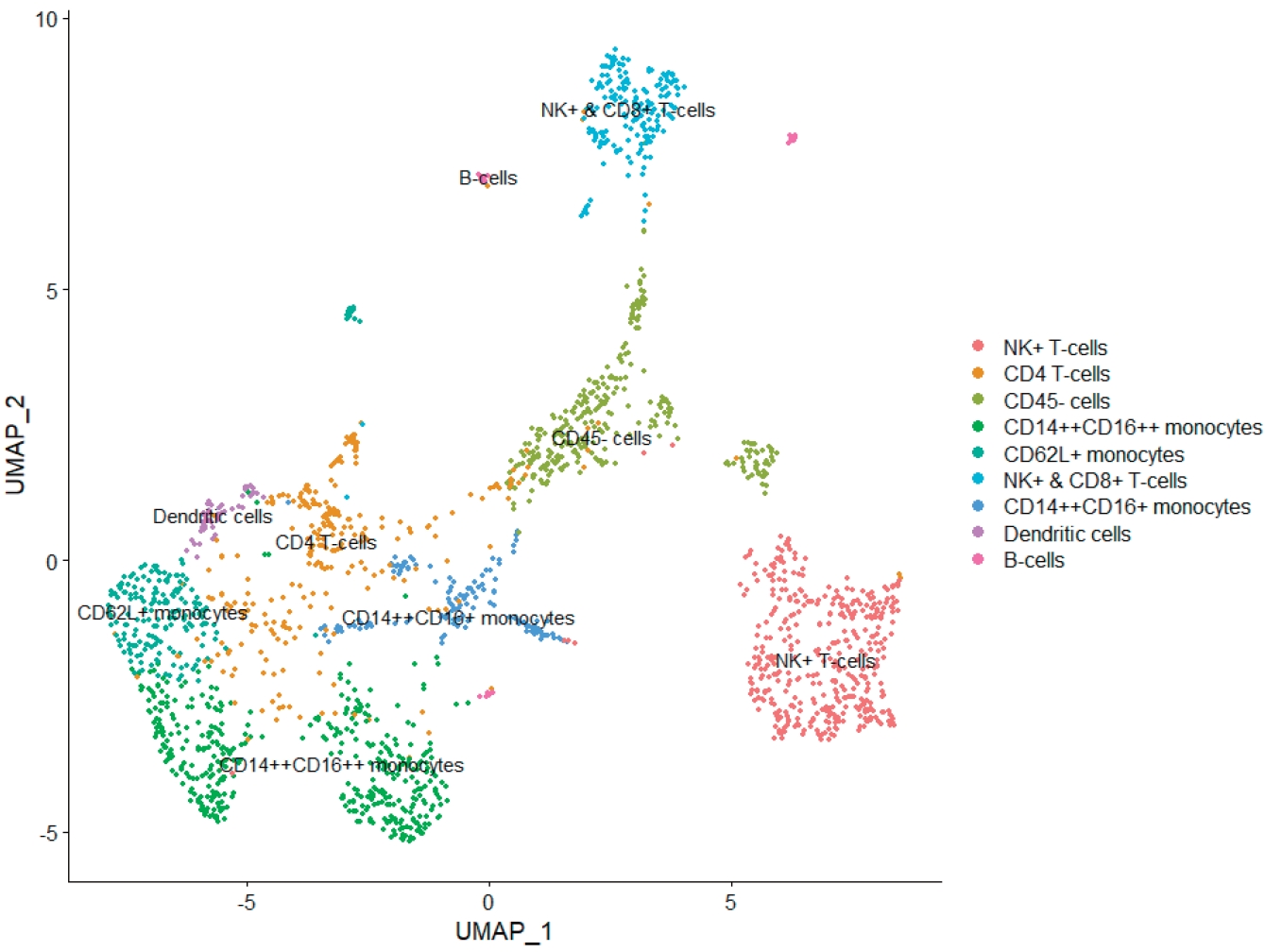
Question: Is there a difference in immune cells in human breast milk by parity?
Finding: There were higher proportions of monocytes and T/B cells in the primiparous and multiparous group, respectively. The expression of genes with a direct role in the infant immune system and immune response-related genes were highest in the primiparous group
Meaning: There were parity-dependent differences in the expression of genes between innate and adaptive immune cells.
- Editorial
- Hematology
- Absolute versus functional iron deficiency
- Hye Lim Jung
- Clin Exp Pediatr. 2025;68(2):138-140. Published online November 13, 2024
-
· Iron deficiency (ID), the most common cause of anemia, can be classified into absolute and functional types. Absolute ID is a state of low total body iron, while functional ID is a state of imbalance between iron demand and iron availability due to inflammation and/or infection.
· ID is diagnosed by serum ferritin and transferrin saturation levels.
- Allergy
- Effect of metabolic syndrome on pulmonary dysfunction in children with asthma
- Hyo-Bin Kim
- Clin Exp Pediatr. 2025;68(2):136-137. Published online November 13, 2024
-
· The prevalence of metabolic syndrome increased in Korean children during the coronavirus disease 2019 pandemic owing to reduced physical activity resulting from social distancing.
· Metabolic syndrome impacts pulmonary dysfunction in childhood asthma.
· Further studies are needed to understand the mechanism linking asthma and metabolic syndrome and develop interventions.
- Review Article
- Gastroenterology
- Value of transabdominal ultrasonography for diagnosing functional constipation in children: a systematic review and meta-analysis
- Duc Long Tran, Phu Nguyen Trong Tran, Paweena Susantitaphong, Phichayut Phinyo, Palittiya Sintusek
- Clin Exp Pediatr. 2025;68(2):127-135. Published online November 13, 2024
-
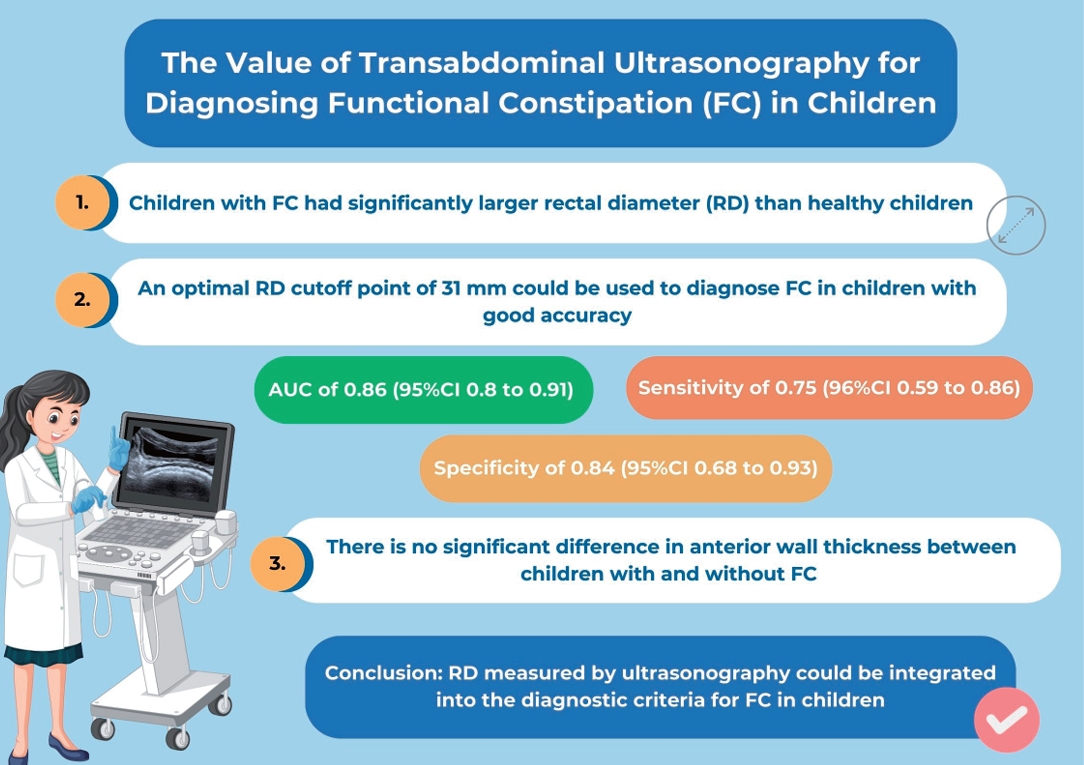
Transabdominal ultrasonography is increasingly used as a novel modality for detecting pediatric functional constipation (FC). This systematic review and metaanalysis aimed to assess the diagnostic parameters of FC including rectal diameter (RD) and anterior rectal wall thickness. A systematic search was conducted of the Ovid MEDLINE, Embase, Scopus, and PubMed databases through September 29, 2023, to identify studies comparing RD...
- General Pediatrics
- Prevalence of childhood overweight and obesity in Malaysia: a systematic review and meta-analysis
- Ker Yang Chua, Ker Yung Chua, Karuthan Chinna, Chooi Ling Lim, Maheeka Seneviwickrama
- Clin Exp Pediatr. 2025;68(2):115-126. Published online November 13, 2024
-
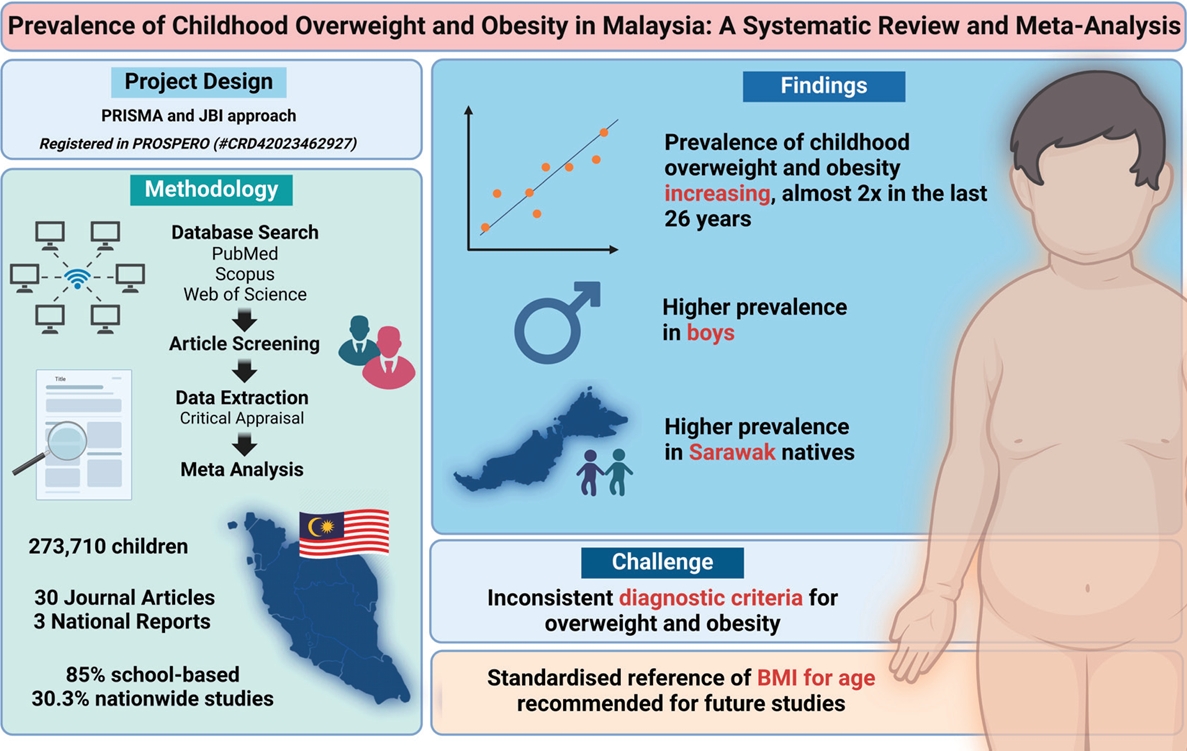
The incidence of childhood obesity is increasing worldwide. National surveys in Malaysia have shown similar trends. This review aimed to increase our understanding of the prevalence and associated factors of childhood overweight, obesity, and excess weight in Malaysia. A systematic review and meta-analysis were conducted of studies reporting the prevalence of overweight and obesity in Malaysian children aged <18 years....
- Hematology
- Promising role of voxelotor in managing sickle cell disease in children: a narrative review
- Amit Agrawal, Gaurav Jadon, Japna Singh, Dalwinder Janjua
- Clin Exp Pediatr. 2025;68(2):106-114. Published online November 13, 2024
-

Voxelotor has promising ability to increase hemoglobin levels and reduce hemolysis markers in patients with sickle cell disease (SCD). Several preclinical and phase II/III trials have demonstrated its efficacy, dose-dependent responses, and tolerability in children. Ongoing trials are assessing its safety and effectiveness in various populations, including children younger than 12 years. These findings suggest its potential as a disease-modifying drug, warranting further exploration of its role in SCD management.
- Letter to the Editor
- Other
- Adolescent hypertension and carotid intima-media thickness: significance of submillimetric differences
- Christian Saleh
- Clin Exp Pediatr. 2025;68(1):104-105. Published online November 28, 2024
-
- Original Article
- Neurology
- Instability of revised Korean Developmental Screening Test classification in first year of life
- Ji Eun Jeong, You Min Kim, Na Won Lee, Gyeong Nam Kim, Jisuk Bae, Jin Kyung Kim
- Clin Exp Pediatr. 2025;68(1):97-103. Published online November 11, 2024
-

Question: How stable are the revised Korean Developmental Screening Test score classifications in early infancy?
Finding: A significant number of infants improved into the peer and high-level group (≥-1 standard deviations), especially in the gross motor area.
Meaning: The early detection of developmental delay requires a comprehensive medical history, physical and neurological examinations, and repeated developmental screenings.
- Endocrinology
- Efficacy of leuprolide acetate versus triptorelin pamoate administered every 3 months for treatment of central precocious puberty
- Thanaporn Thaneetrakool, Suphab Aroonparkmongkol, Nattakarn Numsriskulrat, Vichit Supornsilchai, Suttipong Wacharasindhu, Khomsak Srilanchakon
- Clin Exp Pediatr. 2025;68(1):91-96. Published online November 6, 2024
-

Question: What are the differences in efficacy between leuprolide acetate and triptorelin pamoate administered every 3 months for the treatment of central precocious puberty (CPP)?
Finding: There were no significant intergroup differences in luteinizing hormone suppression or predicted adult height at the end of treatment in girls with CPP.
Meaning: Leuprolide acetate and triptorelin pamoate have comparable efficacy for treating CPP.
- Pulmonology
- Polysomnographic features of children with obesity: body mass index predict severe obstructive sleep apnea in obese children?
- Rungrat Sukharom, Prakarn Tovichien, Kanokporn Udomittipong, Pinyapach Tiamduangtawan, Wattanachai Chotinaiwattarakul
- Clin Exp Pediatr. 2025;68(1):80-90. Published online November 6, 2024
-

Question: How Common is obstructive sleep apnea (OSA) in obese children? OSA is common in obese children, even without habitual snoring.
Finding: Among the subjects, 60.6% had positional OSA, 40.2% had rapid eye movement-related OSA, 59.8% had desaturation, 20.5% had sleep-related hypoventilation, and 5.0% had obesity hypoventilation syndrome. Body mass index (BMI) and neck and waist circumferences were significantly associated with severe OSA.
Meaning: We recommend screening obese children (BMI > 29.2 kg/m2) for OSA.
- Neonatology (Perinatology)
- Short-term outcomes of oropharyngeal administration of colostrum in preterm neonates: a double-blind placebocontrolled randomized trial
- Ameneh Lamsehchi, Maryam Shokouhi Solgi, Mohammad Kazem Sabzehei, Behnaz Basiri, Elahe Talebi Ghane, Kiana Kimiaei Asadi, Sina Azadnajafabad
- Clin Exp Pediatr. 2025;68(1):73-79. Published online October 31, 2024
-

Question: What are the short-term outcomes of oropharyngeal administration of colostrum (OAC) in preterm neonates?
Finding: This study demonstrated the significantly lower rates of necrotizing enterocolitis, clinically suspected sepsis, shorter hospital stay, period to full enteral feeding, and antibiotic therapy period in the OAC group.
Meaning: This trial may further expand the clinical application of OAC in premature infants to reduce their length of hospital stay and complications.
- Infection
- Carbapenem resistance in gram-negative pathogens in an Iranian hospital: high prevalence of OXA-type carbapenemase genes
- Setareh Mamishi, Reihaneh Hosseinpour Sadeghi, Sadaf Sajedi Moghaddam, Babak Pourakbari, Shiva Poormohammadi, Maryam Sotoudeh Anvari, Shima Mahmoudi
- Clin Exp Pediatr. 2025;68(1):65-72. Published online October 31, 2024
-

Question: What is the prevalence of carbapenem resistance in gram-negative bacteria and associated carbapenemase genes?
Findings: This study identified a notable prevalence of carbapenem-resistant gram-negative isolates, with Escherichia coli being the predominant contributor, follow ed by Klebsiella pneumoniae, Acinetobacter baumannii, while bla OXA48 was the most prevalent carbapenemase gene.
Meaning: These findings highlight the urgent need for proactive measures including the rapid detection of carbapenemase- producing isolates and effective infection control.
- Editorial
- Cardiology
- What we should know about pediatric heart failure: children are not small adults
- Ja-Kyoung Yoon
- Clin Exp Pediatr. 2025;68(1):62-64. Published online November 6, 2024
-
· Pediatric heart failure (PHF) features high morbidity and mortality rates.
· Although adults and children can share a common diagnosis of heart failure, the underlying causes can differ significantly and require distinct therapeutic approaches.
· Treatments designed for adults are often applied to PHF despite the fundamental physiological and developmental differences between them.
· Child-specific data are vital for the development of tailored treatments to meet the unique needs of patients with PHF.
- Review Article
- Neonatology (Perinatology)
- Need for national guidance regarding proactive care of infants born at 22–23 weeks' gestation
- Ga Won Jeon
- Clin Exp Pediatr. 2025;68(1):53-61. Published online November 13, 2024
-

With advancements in neonatal intensive care, the limit of viability has shifted to 22–23 weeks' gestation, whose survival rates vary across countries and institutions. These rates are not static and can be improved through the proactive and centralized care guided by national protocols, including maternal transfer to high-activity regions with better neonatal intensive care practices before delivery.
-

-
-
6.02024CiteScore98th percentilePowered by
-
Impact Factor3.6
-
- TOPICS
- ARTICLE CATEGORY
- Editorial Office
-
Korean Pediatric Society
#1606 Seocho World Officetel, 19 Seoun-ro, Seocho-ku, Seoul 06732, Korea
Tel: +82-2-3473-7306 Fax: +82-2-3473-7307 E-mail: office@e-cep.org
Clinical and Experimental Pediatrics is an open access journal. All articles are distributed under the terms of the Creative Commons Attribution NonCommercial License (http://creativecommons.org/licenses/by-nc/4.0/)
Copyright © 2025 by Korean Pediatric Society.











